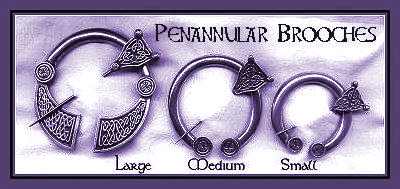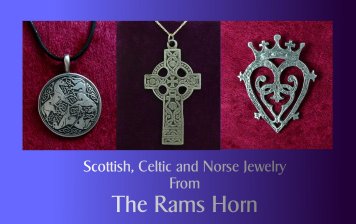HOME | home
About the Artists | Custom Design | Custom Pieces | Custom Pieces 3 | Lost Wax Casting | Celtic Pewter | Pewter History
Pewter History

By Beth Maxwell Boyle, BFA
Pewter is a wonderful metal with a long history. The origin of the word Pewter is not fully known, but it is probably an English modification of the word spelter. It was adopted with only slight variation by most of the continental European nations. At an early period Europeans became very fond of pewter wares. The word pewter became peauter in Dutch, peutre, peautre or piautre in French, peltro in Italian and peltre in Spanish. Roman pewter, the oldest known, which has been uncovered at various sites in England and elsewhere, was composed of tin and lead alone. Occasional traces of iron are believed to be accidental.
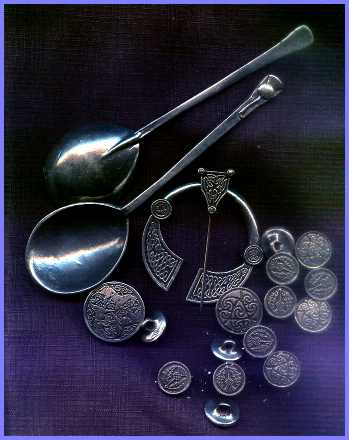
Some people think of Pewter as a cheap substitute for Sterling silver but this it is not. Pewter is a splendid metal with its own merits and qualities that make it a fine precious metal for both decorative and practical applications. Pewter historically was an alloy of *tin and lead (up to 50% Pb). It became popular in kitchen ware such as plates, mugs, and utensils. By the mid-1700s the health hazards and tarnishing drawbacks of leaded pewter helped popularize Britannia metal a non-leaded form of pewter. Britannia metal consists of* tin, *antimony, and *copper. Pewter is a general name used to denote a number of alloys of various metals in diverse proportions, the sole common feature of which lies in the fact that tin is always the chief constituent. Tin (Sn) is a relatively soft and ductile metal with a silvery white color. It has a density of 7.29 grams per cubic centimeter, a low melting point of 231.88° C (449.38° F), and a high boiling point of 2,625° C (4,757° F). Most people think of tin cans when they hear the word tin and that makes them think "Cheap". Tin cans were in fact made from iron that was dipped in tin to prevent rusting. Today's "Tin foil" is actually made of aluminum!

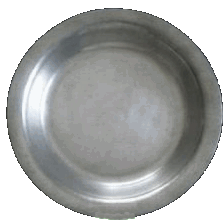
Pewter used for food vessels must be lead free and contain 92% tin, 6.7% antimony, and 1.2 % copper as required by both U.S. Government regulations and the APG (American Pewter Guild).
Tin is in fact a precious and expensive metal. Tin has been mined and used to make objects both decorative and utilitarian for over 3000 years. It's the 4th most precious metal in common usage after platinum, gold and silver. Modern pewter contains about 92% tin and added to this are small amounts of antimony, copper or bismuth to give additional strength. Pewter was probably first made in the Bronze Age (between 2000 and 500 BC). Pewter and bronze are related alloys; pewter is mostly tin, with a small amount of copper (and other ingredients), while bronze is an alloy made up primarily of copper, with a small amount of tin. It has been speculated by historians that pewter was invented when the quantities of metal in the alloy were reversed, whether this was by accident or by design is impossible to tell! By the middle ages the use of pewter in Europe was widespread. Around the 12th. century, pewter was only within the reach of the wealthy, where it was to be found on the tables of castle halls and in the houses of rich merchants and churchmen. Later its use spread into taverns and cottages. It was mainly used for functional items like plates and cutlery, but pewterers also made small decorations and toys, referred to as "trifle".
Somewhere around the 15th century, craftsmen in England began forging tin, that was mined locally in Cornwall, England, into tankards, plates and candlesticks. Pewter later became a common replacement for household items made of clay, leather and wood. The growth of the pewter industry in Europe at this time led to the establishment of guilds, which regulated the quality of work produced by pewterers. "The Worshipful Company of Pewterers" was established in England in 1348 for this purpose. Towards the end of the 18th century however, the mass production of good quality pottery had a dramatic effect on the market for utilitarian pewterware, forcing many pewterers out of business. Despite this by the 1930's, England became world renown for fine pewter craftsmanship, which was the result of their high production and design standards, established guidelines and rigorous testing procedures.
High quality pewter items are made today in the USA that rival those made in the UK. Today pewter items are enjoying an enormous revival, both consumer and craftsman have rediscovered the glowing beauty and practical function of fine pewter. Around the globe pewter is enjoying a Renaissance that grows each year. Here at The Rams Horn Studio we take great pleasure in presenting the very finest pewter castings for sale. All our pewter is hand poured by master jeweler, James Boyle. Our designs are unique and beautiful and perfect for gifts and trophies. Our line continues to grow and our pewter is now available in Australia, the UK, and the USA. For more information on both wholesale and retail pewter from The Rams Horn Studio, follow the links on this page to our products available on Line.
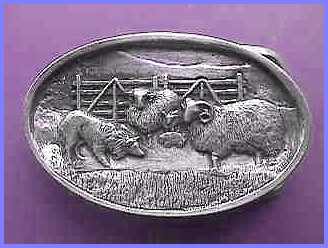
ALL OUR PEWTER IS LEAD FREE!
James E. Boyle, BFA &Beth Maxwell Boyle, BFA
Thank you for your interest in our fine products. We look forward to doing business with you. All of our artwork is made right here in Western, NY. Our original models are created by carving the model in wax and then casting the design in silver. A high heat rubber mold for spin casting is made from that silver model. To learn more about lost wax casting follow the links to the Lost Wax Casting Page.
Our pewter jewelry is poured by hand by James Edward Boyle in fine, lead free, jeweler's pewter that is burnished and antiqued by hand in our studio. Our jewelry is signed and can be considered an investment in Fine Art. We Can produce custom designs for your business or organization using your design or we can design for you. Please write for a price quote. Let James or Beth design that very special award or project for you. All our fine pewter is produced by spin casting.
If you are not familiar with this process, models are carved by hand of wax or wood. These small patterns or originals are layed out on a disc of uncured silicone to create casting cavities. When cured, this rubber mold is spun in a centrifuge while pewter is poured into the center of the mold. Silicone rubber molds can be cycled as many as 50-60 times per hour, for hundreds of cycles. Therefore, a 20 cavity mold can produce 1000 components per hour if small-to-medium production runs are needed. Resulting parts have excellent detail and representative surface finish of the master pattern. Spin-Casting uses adjustable centrifugal force to inject molted metal into a vulcanized silicone rubber cylindrical mold under pressure, completely filling the mold cavities. Venting systems eliminate air pockets and voids to produce beautiful, high quality castings with virtually identical strength, surface finish and dimensional characteristics as those produced by any other processes, at greatly reduced cost and lead times.
The amazing thing about spin casting is that, since pewter melts around 600 degrees or even lower, it doesn't require the labor intensive, mold investment that lost wax casting requires. Using centrifugal force, we simply pour molten metal directly into high temperature rubber molds spinning at high speed and 15 minutes later, we release a cast tree ready for cut-off & finishing. Each piece is then inspected and hand finished by Beth and Jim.
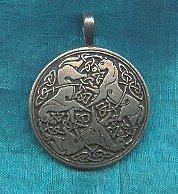
Pewter ware was originally fashioned in two ways, by hammering or by casting, and the workers in each were strictly differentiated, the former, who worked in fine pewter, being known as Sadware men, the latter who used “ley” as Hollow-ware men. A third class, known as Triflers, from the alloy they were limited to, probably at first only manufactured such small articles of domestic use or ornament as did not definitely fall under either of the other headings, but from an authorized list of wares, drawn up by a committee of Trillers in 1612, it is clear that the barrier between them and the Hollowware men had been largely broken down. Another method of working pewter which seems to have been introduced later, and never followed to any great extent, was spinning, by which the vessel was shaped in a mold on a wheel by the mere pressure of a blunt tool, the softness of the metal allowing it to flow sufficiently for this purpose. Today pewter spinning is employed by many major craftsman and manufacturers.
Pewter first appears in western recorded history in 1074, when a synod at Rouer permitted its use as a substitute for gold or silver in church vessels a concession accepted also at Winchester two years later, again withdrawn in 1175, but once more adopted some twenty years after. The records of its domestic use commence with caldrons employed for boiling the meat at the coronation of Edward I. in 1274, though we gather that the trade was even then flourishing in Paris and Bruges, during the following century it extended to Augsburg, Nuremberg, Poitiers, Moos and other continental centres. Confined at first to the more wealthy classes, we can trace the use of pewter as time goes on its extension lower and lower in the social scale, until at the end of the 17th century its use was almost universal. From then on its vogue steadily declined when the growing cheapness of glass and chinaware and the invention of more showy metals brought upon it by degrees the fatal stigma of vulgarity.
Throughout it's long history pewter has had an almost infinite variety of compositions, even today there are still numerous varieties produced. The only common factor is a relatively high tin content which is hardened by additions of other elements. In most countries newly manufactured pewter is a lead free alloy usually being hardened with additions of antimony and copper, containing over 90% tin. Other elements such as silver and bismuth are sometimes used in. In the past pewter often contained lead but as awareness has grown into the harmful effects of lead it has been eliminated. Modern pewter can be polished to a bright silver like finish or if preferred chemical darkeners can be used to simulate the patinas associated with old pewter. At the Rams Horn most of our pewter is burnished after being antiqued to bring out the detail. Our customers mostly prefer this finish to a high shine or to a brushed finish. The pins and other findings are all soldered by hand on our products by James E. Boyle. Our Pewter jewelry is of the highest quality and is meant to last for many years.
Tin
*Tin is the fourth most precious metal in the world and was used by man as early as The Bronze Age. Tin very rarely occurs uncombined in nature. The dioxide, which occurs as cassiterite, or tinstone, is the only ore of commercial importance and is found, in such places as China, Brazil, Bolivia, Indonesia, and Peru. Tin has a relatively low melting point of 450 degrees and alloys well with other metals. It will increase the hardness of an alloy and raise its working temperature. Other characteristics of tin are its softness, its malleability and its high fluidity when molten.
Antimony
*Antimony has been known since the days of ancient Egypt and Rome. It rarely occurs free in nature but its ores are widely found, principally in such places as China, South Africa, Bolivia, Peru and the United States. Antimony is a metalloid element found in mined deposits. It is useful in alloys because it improves its capacity to reproduce detail and it hardens soft metals such as tin.
Copper
*Copper was one of the first known metals to humans and was probably mined in the free state as long ago as the 5th century B.C. Much of the world's copper now comes from the mountain ranges extending from Alaska to the tip of South America. Copper increases the hardness of an alloy and raises its working temperature.
James and Beth Boyle
Our Jewelry contains neither Lead nor Cadmium. The formula is:
Tin: 98%
Bismuth: 1.5%
Copper: 0.25%
Silver: 0.25%
Pewter used for food vessels must be lead free and contain 92% tin, 6.7% antimony, and 1.2 % copper as required by both U.S. Government regulations and the APG (American Pewter Guild).

Established 1980
on the Web since 1997
Dominus Providebit
copyright 2002 , Jim & Beth Boyle, All Rights Reserved
No part of this website may be used for any purpose ( including using images )
without written consent from The Rams Horn

